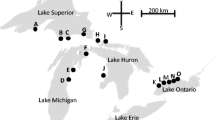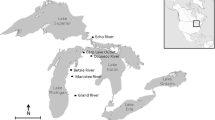Abstract
The female sea lamprey (Petromyzon marinus), a devastating invasive fish of the Laurentian Great Lakes, locates potential mates by tracking a sex pheromone emitted by nesting males. We tested whether combinations of two putative components of the sex pheromone, 3-keto-petromyzonol sulfate (3kPZS) and 3-keto-allocholic acid (3kACA), were sufficiently attractive to function as a trap-bait when placed in direct competition with male odors. Ovulating females successfully located point sources of 3kPZS both in the presence and absence of a competing odor emitted by mature males placed upstream. However, 3kPZS was not able to retain females in the vicinity of a trap longer than two minutes, and retention time was reduced by 57% when competing male odors were present. 3kACA failed to elicit a response on its own and did not improve attraction to, or retention near, a source of 3kPZS. Application of an incomplete pheromone in trapping-for-control scenarios will require devices configured to minimize the effort necessary to enter a trap, features to offset the probable decrease in trap retention, and deployment into favorable habitats where competition with spawning males is minimal.


Similar content being viewed by others
References
Allison JD, Cardé RT (2008) Male pheromone blend preference function measured in choice and no-choice wind tunnel trials with almond moths, Cadra cautella. Anim Behav 75:259–266
Applegate VC (1950) Natural history of the sea lamprey in Michigan. U.S. Fish and Wildlife Service Spec Sci Rep Fish 35
Burnard D, Gozlan RE, Griffiths SW (2008) The role of pheromones in freshwater fishes. J Fish Biol 73:1–16
Christie GC, Goddard CI (2003) Sea Lamprey International Symposium (SLIS II): advances in the integrated management of sea lamprey in the Great Lakes. J Great Lakes Res 29:1–14
Fontaine M (1938) La lamproie marine. Sa peche et son importance economique. Bull Sco Oceanogr Fr 17:1681–1687
Great Lakes Fishery Commission (2001) Strategic vision of the Great Lakes Fishery Commission for the first decade of the new millennium.Great Lakes Fish. Comm., Ann Arbor, MI, USA
IUCN (2010) IUCN Red List of Threatened Species. Version 2010.3. Retrieved from http://www.iucnredlist.org on 02 September 2010
Johansson BG, Jones TM (2007) The role of chemical communication in mate choice. Biol Rev 82:265–289
Johnson NS, Siefkes MJ, Li W (2005) Capture of ovulating female sea lampreys in traps baited with spermiating male sea lampreys. N Am J Fish Manag 25:67–72
Johnson NS, Yun SS, Thompson HT, Brant CO, Li W (2009) A synthesized pheromone induces upstream movement in female sea lamprey and summons them into traps. Proc Nat Assoc Sci (USA) 106:1021–1026
Li W (2005) Potential multiple functions of a male sea lamprey pheromone. Chem Sens 30:i301–i308
Li W, Scott AP, Siefkes MJ, Yan H, Liu Q, Yun S-S, Gage DA (2002) Bile acid secreted by male sea lamprey that acts as a sex pheromone. Science 296:138–141
Li W, Twohey MB, Jones ML, Wagner CM (2007) Research to guide use of pheromones to control sea lamprey. J Great Lakes Res 33:70–86
Madenjian CP, O’Gorman R, Bunnell RL, Argyle RL, Roseman EF, Warner DM, Stockwell JD, Stapanian MA (2008) Adverse effects of alewives on Laurentian Great Lakes fish communities. N Am J Fish Mgmt 28:263–282
McLennan DA (2003) The importance of olfactory signals in the gasterosteid mating system: sticklebacks go multimodal. Biol J Linn Soc 80:555–572
Moore P, Crimaldi J (2004) Odor landscapes and animal behavior: tracking odor plumes in different physical worlds. J Mar Sys 49:55–64
Murphy BR, Willis DW (1996) Fisheries Techniques: Second Edition. American Fisheries Society Bethesda, Maryland, USA
Papke RS, Kemp DJ, Rutowski RL (2007) Multimodal signaling: structural ultraviolet reflectance predicts male mating success better than pheromones in the butterfly Colias eurytheme L. (Pieridae). Anim Beh 73:47–54
Rybak F, Sureau G, Aubin T (2002) Functional coupling of acoustic and chemical signals in the courtship behaviour of the male Drosophila melanogaster. Proc Royal Soc Lond Ser B-Biol Sci 269(1492):695–701
Shine R (2005) All at sea: aquatic life modifies mate-recognition modalities in sea snakes (Emydocephalus annulatus, Hydrophiidae). Beh Ecol Sociobiol 57:591–598
Siefkes MJ, Li W (2004) Electrophysiological evidence for detection and discrimination of pheromonal bile acids by the olfactory epithelium of female sea lampreys (Petromyzon marinus). J Comp Phys A 190:193–199
Siefkes MJ, Bergstedt RA, Twohey MB, Li W (2003a) Chemosterilization of male sea lampreys (Petromyzon marinus) does not affect sex pheromone release. Can J Fish Aquat Sci 60:23–31
Siefkes MJ, Scott AP, Zielinski B, Yun S, Li W (2003b) Male sea lampreys, Petromyzon marinus L., excrete a sex pheromone from the gill epithelia. Biol Reprod 60(1):125–132
Siefkes MJ, Winterstein SR, Li W (2005) Evidence that 3-keto petromyzonal sulfate specifically attracts ovulating female sea lamprey (Petromyzon marinus). Anim Beh 70:1037–1045
Smith SH (1970) Species interactions of the alewife in the Great Lakes. Trans Am Fish Soc 99:754–765
Smith BR, Tibbles JJ (1980) Sea lamprey (Petromyzon marinus) in Lakes Huron, Michigan, and Superior—History of invasion and control. 1936–1978. Can J Fish Aquat Sci 37:1780–1801
Sorensen PW, Stacey NE (2004) Brief review of fish pheromones and discussion of their possible uses in the control of non-indigenous teleost fishes. N Zeal J Mar FW Res 38:399–417
Stacey NE, Sorensen PW (2002) Fish hormonal pheromones. In: Pfaff DW, Arnold AP, Etgen S, Fahrbach S, Rubin R (eds) Hormones, brain and behavior. Academic Press, New York, pp 375–435
Teeter J (1980) Pheromone communication in sea lampreys: implications for population management. Can J Fish Aquat Sci 37:2123–2132
Thompson RR, George K, Dempsey J, Walton JC (2004) Visual sex discrimination in goldfish: seasonal, sexual, and androgenic influences. Hor Behav 46:646–654
Twohey MB, Sorensen PW, Li W (2003) Possible applications of pheromones in an integrated sea lamprey management program. J Great Lakes Res 29:794–800
U.S. Fish and Wildlife Service (2010) List of Extinct Species in the Midwest Region. Retrieved from http://www.fws.gov/midwest/endangered/lists/extinct.html on 02 September 2010
Vickers NJ (2000) Mechanism of animal navigation in odor plumes. Biol Bull 198:203–212
Wagner CM, Jones ML, Twohey MB, Sorensen PW (2006) A field test verifies that pheromones can be useful for sea lamprey (Petromyzon marinus) control in the Great Lakes. Can J Fish Aquat Sci 63:475–479
Wagner CM, Twohey MB, Fine JM (2009) Conspecific cueing in the sea lamprey: do reproductive migrations consistently follow the most intense larval odour? Anim Beh 78:593–599
Weissburg MJ (2000) The fluid dynamical context of chemosensory behaviour. Biol Bull 198:188–202
Yun SS, Scott AP, Li W (2003) Pheromones of the male sea lamprey, Petromyzon marinus L.: structural studies on a new compound, 3-keto allocholic acid, and 3-keto petromyzonol sulfate. Steroids 68:297–304
Acknowledgments
We are grateful to MiDNR for access to the Ocqueoc River from state land. We thank the staffs of the Hammond Bay Biological Station and U.S. Fish and Wildlife Service Marquette Biological Station for providing experimental subjects and access to holding and laboratory facilities. Matt Altenritter (MSU), Gale Bravener (Department of Fisheries and Oceans Canada), and Scott Marvin (U.S. Fish and Wildlife Service), provided technical assistance in the field. We thank Erin Dreelin, Nick Johnson and Jim Miller for insightful discussions and for reviewing early drafts of this manuscript. This research was funded by the Great Lakes Fishery Commission via grants to C.M.W. (field experiments) and W. Li (verification of synthesized compounds), as well as the Partnership for Ecosystem Research and Management with Michigan State University. The final manuscript was substantially improved thanks to the comments of an anonymous referee.
Author information
Authors and Affiliations
Corresponding author
Rights and permissions
About this article
Cite this article
Luehring, M.A., Wagner, C.M. & Li, W. The efficacy of two synthesized sea lamprey sex pheromone components as a trap lure when placed in direct competition with natural male odors. Biol Invasions 13, 1589–1597 (2011). https://doi.org/10.1007/s10530-010-9916-3
Received:
Accepted:
Published:
Issue Date:
DOI: https://doi.org/10.1007/s10530-010-9916-3




